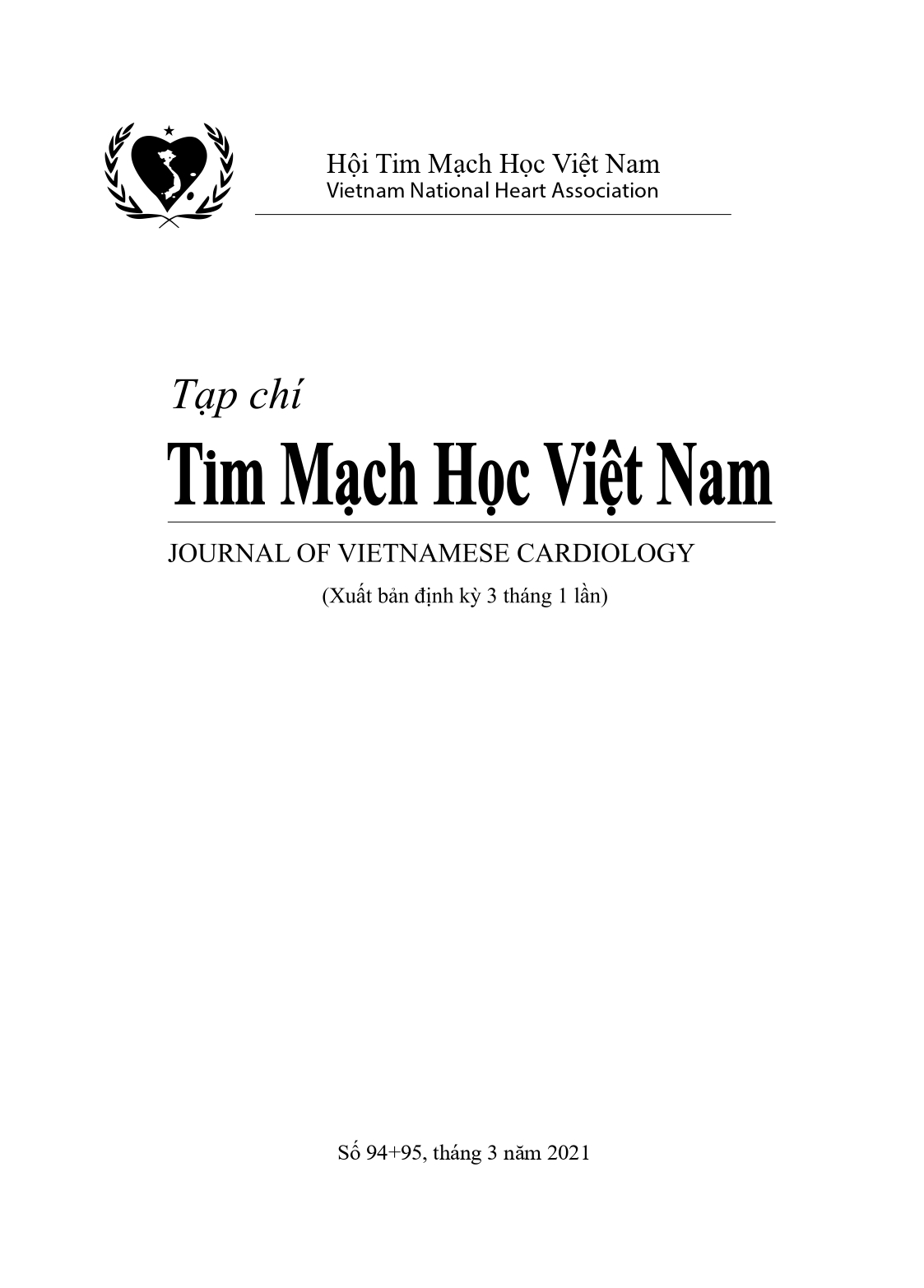Giá trị tiên lượng của acid uric với tỷ lệ tử vong của bệnh nhân suy tim cấp
DOI:
https://doi.org/10.58354/jvc.94+95.2021.162Tóm tắt
Tổng quan: Nồng độ acid uric (AU) huyết thanh đã được biết đến là một yếu tố tiên lượng trong bệnh lý suy tim. Tuy nhiên giá trị tiên lượng của nồng độ AU cao và những yếu tố tác động làm tăng acid uric trong suy tim cấp chưa được biết rõ.
Phương pháp: 200 bệnh nhân suy tim cấp phải nhập viện được đưa vào nghiên cứu. Các bệnh nhân này sẽ được phân loại thành 2 nhóm: Nhóm có nồng độ AU huyết thanh thấp (Nam < 7 mg/dL, nữ < 6 mg/dL, n=55) và nhóm có nồng độ AU huyết thanh cao (Nam >7, nữ >6, n=155) tùy theo giá trị nồng độ AU được định lượng trong vòng 24h sau nhập viện. Bệnh nhân nghiên cứu được theo dõi cho đến 6 tháng sau xuất viện.
Kết quả: Đường cong Kaplan – Meier cho thấy tỷ lệ sống còn ở nhóm AU thấp cao hơn có ý nghĩa so với nhóm AU cao. Phân tích hồi quy Cox đa biến cho thấy nồng độ AU cao (HR: 1,135 95%CI 1,023 – 1,258) là một yếu tố tiên lượng độc lập tử vong trong vòng 6 tháng.
Kết luận: Nồng độ AU là một yếu tố tiên lượng độc lập trên bệnh nhân suy tim cấp phải nhập viện.
Từ khóa: Acid uric, suy tim cấp, tử vong.
Tài liệu tham khảo
1. BenjaminEJ,MuntnerP,AlonsoA,etal. Heart Disease and Stroke Statistics-2019 Update: A Report From the American Heart Association. Circulation. 2019;139(10):e56-e528.
![]()
2. Heidenreich PA, Albert NM, Allen LA, et al. Forecasting the impact of heart failure in the United States: a policy statement from the American Heart Association. Circ Heart Fail. 2013;6(3):606-619.
![]()
3. Solomon SD, Dobson J, Pocock S, et al. Influence of nonfatal hospitalization for heart failure on subsequent mortality in patients with chronic heart failure. Circulation. 2007;116(13):1482-1487.
![]()
4. Adams KF, Jr., Fonarow GC, Emerman CL, et al. Characteristics and outcomes of patients hospitalized for heart failure in the United States: rationale, design, and preliminary observations from the first 100,000 cases in the Acute Decompensated Heart Failure National Registry (ADHERE). Am Heart J. 2005;149(2):209-216.
![]()
5. ClelandJG,SwedbergK,FollathF,etal. The EuroHeart Failure survey programme-- a survey on the quality of care among patients with heart failure in Europe. Part 1: patient characteristics and diagnosis. Eur Heart J. 2003;24(5):442-463.
![]()
6. Follath F, Yilmaz MB, Delgado JF, et al. Clinical presentation, management and outcomes in the Acute Heart Failure Global Survey of Standard Treatment (ALARM-HF). Intensive Care Med. 2011;37(4):619-626.
![]()
7. Fonarow GC, Abraham WT, Albert NM, et al. Influence of a performance-improvement initiative on quality of care for patients hospitalized with heart failure: results of the Organized Program to Initiate Lifesaving Treatment in Hospitalized Patients With Heart Failure (OPTIMIZE-HF). Arch Intern Med. 2007;167(14):1493-1502.
![]()
8. Komajda M, Follath F, Swedberg K, et al. The EuroHeart Failure Survey programme--a survey on the quality of care among patients with heart failure in Europe. Part 2: treatment. Eur Heart J. 2003;24(5):464-474.
![]()
9. Nieminen MS, Brutsaert D, Dickstein K, et al. EuroHeart Failure Survey II (EHFS II): a survey on hospitalized acute heart failure patients: description of population. Eur Heart J. 2006;27(22):2725-2736.
![]()
10. Ilieșiu AM, Hodorogea AS. Treatment of heart failure with preserved ejection fraction. In: Heart Failure: From Research to Clinical Practice. Springer; 2018:67-87.
![]()
11. Alimonda AL, Nunez J, Nunez E, et al. Hyperuricemia in acute heart failure. More than a simple spectator? Eur J Intern Med. 2009;20(1):74-79.
![]()
12. Okazaki H, Shirakabe A, Kobayashi N, et al. The prognostic impact of uric acid in patients with severely decompensated acute heart failure. J Cardiol. 2016;68(5):384-391.
![]()
13. PonikowskiP,VoorsA,AnkerS,etal. Authors/Task Force Members; Document Reviewers (2016) 2016 ESC Guidelines for the diagnosis and treatment of acute and chronic heart failure: The Task Force for the diagnosis and treatment of acute and chronic heart failure of the European Society of Cardiology (ESC). Developed with the special contribution of the Heart Failure Association (HFA) of the ESC. 2016;18(8):891-975.
![]()
14. Sato N, Kajimoto K, Asai K, et al. Acute decompensated heart failure syndromes (ATTEND) registry. A prospective observational multicenter cohort study: rationale, design, and preliminary data. 2010;159(6):949-955. e941.
![]()
15. Tsutsui H, Tsuchihashi-Makaya M, Kinugawa S, Goto D, Takeshita A, journal J-CIJC. Clinical characteristics and outcome of hospitalized patients with heart failure in Japan. 2006;70(12):1617-1623.
![]()
16. Shiba N, Shimokawa HJVH, Management R. Chronic heart failure in Japan: implications of the CHART studies. 2008;4(1):103.
![]()
17. PalazzuoliA,RuoccoG,PellegriniM,etal. Prognostic significance of hyperuricemia in patients with acute heart failure. 2016;117(10):1616-1621.
![]()
18. Pascual‐Figal DA, Hurtado‐Martínez JA, Redondo B, Antolinos MJ, Ruiperez JA, Valdes MJEjohf. Hyperuricaemia and long‐term outcome after hospital discharge in acute heart failure patients. 2007;9(5):518-524.
![]()
19. HuangW-M,HsuP-F,Cheng H-M, et al. Determinants and prognostic impact of hyperuricemia in hospitalization for acute heart failure. 2015:CJ-15-0964.
![]()
20.HuangG,QinJ,DengX,etal. Prognostic value of serum uric acid in patients with acute heart failure: A meta-analysis. 2019;98(8).
![]()
21. HuangH,HuangB,LiY,etal. Uric acid and risk of heart failure: a systematic review and meta‐analysis. 2014;16(1):15-24.
![]()
Tải xuống
Đã Xuất bản
Các phiên bản
- 04-03-2023 (2)
- 04-03-2023 (1)








